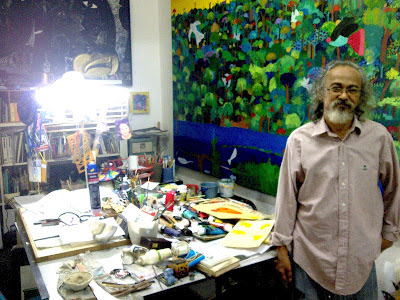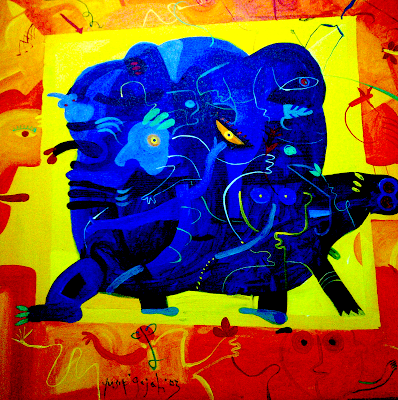
www.kopihangtuah.blogspot.com
Malays were believed to have been evolved from humans migrated from the Southern China/Tibetian region. How true is that theory?
ALAYS were believed to have been evolved from a Northern species of humans migrated from the Southern China/Tibetian region. Such was the conclusion reached back in the 1930's as supported by archaeological findings. How true is that theory? What we must not deny is that scientific conclusions derived from scientific findings are often, if not, mostly, based on a set of assumptions that was conveniently inserted into the equation for a simple reason such as "to fill in the missing pieces". In my past blog post, I supported this theory on the grounds of knowledge being passed down to me by the elderly parties. The danger with this approach is that we unnecessarily create a myopic view that blinds us from the possibilities of other explanations that may lend better credibility in our quest for the truth. A good analogy would be to assume that the world is flat given that water falls at cliffs by the rivers in the absence of the theory of gravity in the centre core of a sphere Earth.
After much debate with fellow bloggers and readings of various researches (the best being Tamadun Alam Melayu by M.A. Ishak in 2009 as published by Persatuan Sejarah Malaysia), I now have doubts over the theory of migrants from the North. It seems that there are new empirical evidences that suggest that Malays exist in the Southeast Asian region even during prehistoric times alongside the Negritos. Southeast Asia is believed to have been one large block of land which later broke up to form the Malay Archipelago following rises in sea levels three times from 14,000 to 8,000 years ago (findings by Stephen Oppenheimer in 2001 in his book Eden in the East, also quoted in the New Straits Times on 7 November 2012). Some of the Negroids from Africa arrived in Southeast Asia about 70,000 years ago and settled in without the evolution in their genetics. Their descendants are the aboriginals of Papua New Guinea and Australia as well as the Negritos that we see in Malaysia.
Instead of man travelling from the North to Southeast Asia, it is now believed that man travelled from Southeast Asia to the North. The African originated people travelled North and underwent genetic evolution that resulted in them mutating into the Tibetans, Thais, Koreans, Japanese and Chinese. This suddenly creates an equation whereby Southeast Asians are the subset of Africans and Orientals are the subset of Southeast Asians. A DNA study conducted in Asia in 2009 revealed otherwise. Coupled with historical records from China, the earlier theory of migration from North to South still is supportable. Perhaps movements happened in both directions?
From logic point of view, the evidences that concluded migration from South to North ought to be the more reasonable conclusion of human evolution on the basis that chronologically, it should have happened earlier on the account of the 'One Large Block of Land' theory. For all you know, the migration from North to South may have been warranted by political movements. Another evidence of Malays being more ancient from the Orientals would be the diversity in the Malay Language whereby it is recorded to be of highest diversity suggesting ancient effects of evolution.
"... at least 3 major religions implied that man originated from middle Earth (i.e. African - Middle Eastern region). They are Islam, Christianity and Judaism"
From logic point of view, the evidences that concluded migration from South to North ought to be the more reasonable conclusion of human evolution on the basis that chronologically, it should have happened earlier on the account of the 'One Large Block of Land' theory. For all you know, the migration from North to South may have been warranted by political movements. Another evidence of Malays being more ancient from the Orientals would be the diversity in the Malay Language whereby it is recorded to be of highest diversity suggesting ancient effects of evolution.
There has been no historical account of Malays migrating from anywhere. DNA studies suggest that human DNAs in Southeast Asia are much older than its counterparts in the North. This can only mean that Malays may have evolved from a more ancient species of African origin, only to be separated from the main land when the so called 'One Large Block of Land' broke into the Malay Archipelago causing the Malays to be maritime masters. The maritime skills eventually spread the Malays onto the Pacific Islands currently known as the Polynesians and Micronesians as well as onto Indian Ocean Islands particularly Madagascar. This theory is readily supportable by DNA studies resulting in the coupled term "Malayo-Polynesian".
"... conclude that man migrated from Africa - Middle East region to the Malay Archipelago and then to the North"
Like many other theories formed from findings, this thoughts on the Malay origin needs to be carefully analysed. It has deep implications in defining who the inhabitants of this land called Malaysia from chronological perspective. It has bearing in determining who formed the first effective government and it has political implications with respect to indigenous provisions. On the account of historical records, we concluded that man migrated and evolved from North to South. From geographical and DNA studies, we concluded that man migrated from Africa to Southeast Asian and then to the North. In the absence of believable evidence, we tend to fall back on faith. Well, from religion point of view, at least 3 major religions implied that man originated from middle Earth (i.e. African - Middle Eastern region). They are Islam, Christianity and Judaism.
The Muslims believe that Adam and Hawa (Eve) were expelled from the heavens only to land at what we now refer to as Saudi Arabia and India. The Jewish and Christian records of their prophets (Noah & Abraham) suggest that the early civilisations of Sumeria, Arcadia, Assyria, Mesopotamia and Babylon emerged in the middle region of what is currently referred to as Iraq. With such biblical influence, it is probably more religious to conclude that man migrated from Africa - Middle East region to the Malay Archipelago and then to the North. Whatever the truth is, what is more encouraging is that Malays existed long enough to have established the great empires of the Malay Archipelago and will continue to be the inhabitants of this region. In the fine words of a Malay warrior, Hang Tuah, "Ta' Melayu Hilang Di Dunia" (Extinct Not, The Malays).
The Muslims believe that Adam and Hawa (Eve) were expelled from the heavens only to land at what we now refer to as Saudi Arabia and India. The Jewish and Christian records of their prophets (Noah & Abraham) suggest that the early civilisations of Sumeria, Arcadia, Assyria, Mesopotamia and Babylon emerged in the middle region of what is currently referred to as Iraq. With such biblical influence, it is probably more religious to conclude that man migrated from Africa - Middle East region to the Malay Archipelago and then to the North. Whatever the truth is, what is more encouraging is that Malays existed long enough to have established the great empires of the Malay Archipelago and will continue to be the inhabitants of this region. In the fine words of a Malay warrior, Hang Tuah, "Ta' Melayu Hilang Di Dunia" (Extinct Not, The Malays).
In the fine words of a Malay warrior, Hang Tuah, "Ta' Melayu Hilang Di Dunia" (Extinct Not, The Malays).

* kopihangtuah
(Note: Most information in this article was sourced from the New Straits Times article "Malay Origins : Evidence Suggests Otherwise" by A.I. Kuala Lumpur, published on 7 November 2012)
| mcmlxxv:viii:xxix |



































